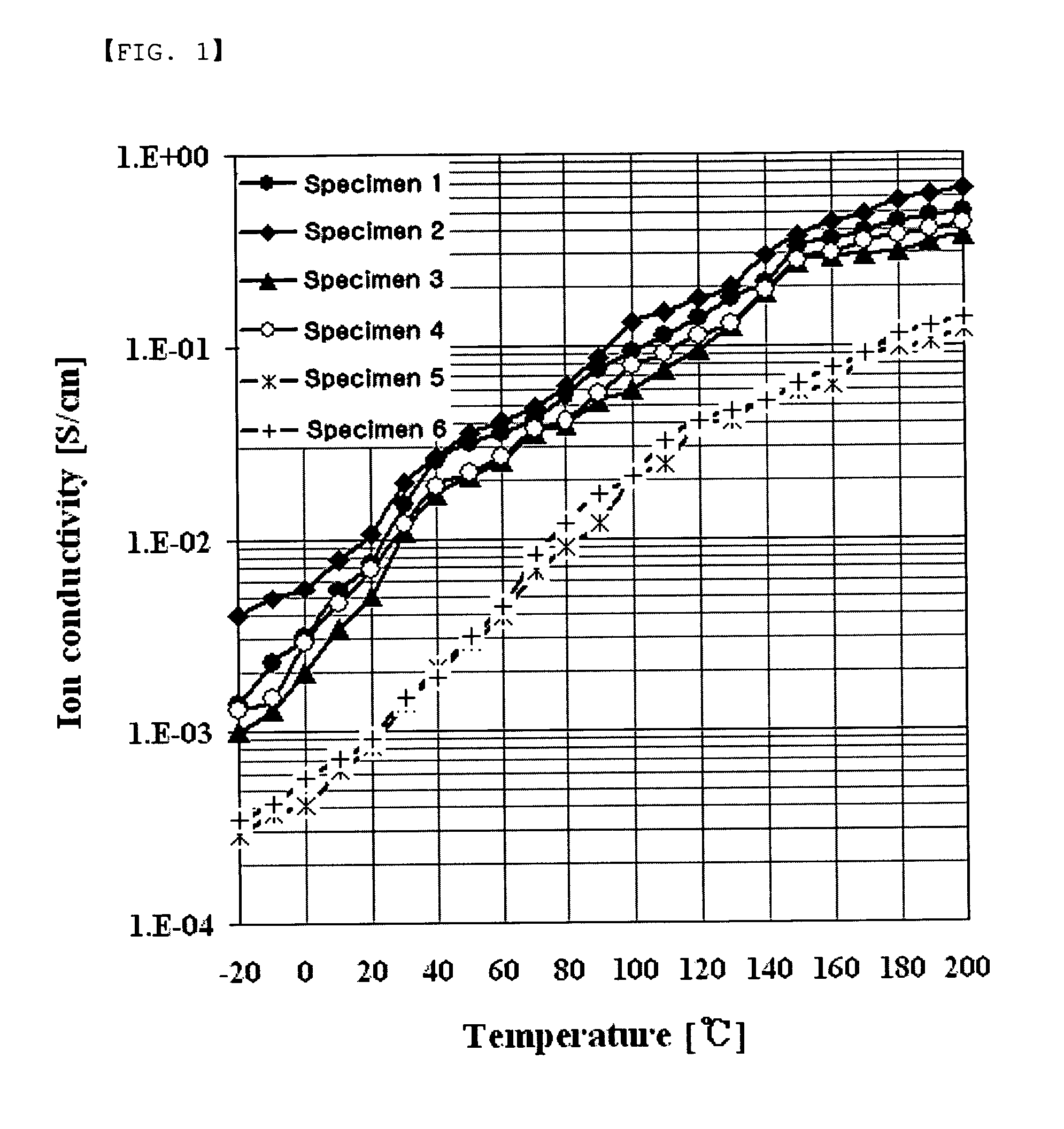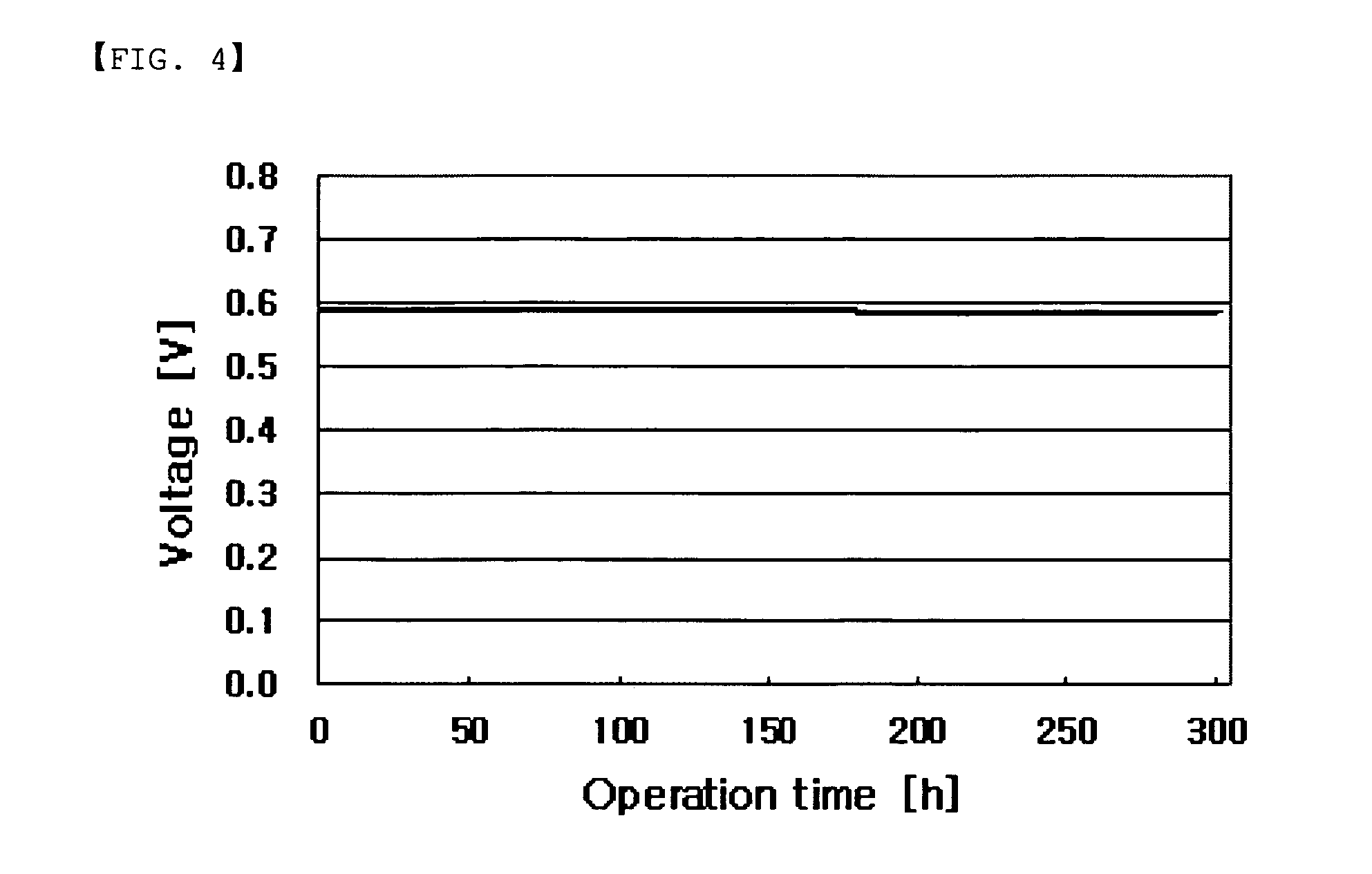Branched multiblock polybenzimidazole-benzamide copolymer and method for preparing the same, electrolyte membrane and paste/gel prepared therefrom
a polybenzimidazole and copolymer technology, applied in the field ofbranched multiblock polybenzimidazolebenzamide copolymer and a method for preparing the same, can solve the problems of difficult to remove the remaining dimethylacetamide, difficult method for preparing a polybenzimidazole membrane using a dimethylacetamide solvent, and serious deterioration of fuel cells. achieve the effect of improving performan
- Summary
- Abstract
- Description
- Claims
- Application Information
AI Technical Summary
Benefits of technology
Problems solved by technology
Method used
Image
Examples
example
Example 1
Preparation of Branched Multiblock Polybenzimidazole-Benzamide Copolymer [Branched Multiblock poly(2,2′-p-(phenylene)-5,5′-bibenzimidazole)- / / -poly(2,5-benzimidazole)- / / -poly(p-benzamide)] (80-15-5% by Weight) (1)
[0088] Dicarboxylic acid and 3,3′,4,4′-tetraaminobiphenyl used for polymerization were dried at 80° C. for at least 24 hours in a vacuum, and 3,4-diaminobenzoic acid was purified from distilled water by recrystallization. That is, 5 g of 3,4-diaminobenzoic acid was added to 100 mL of distilled water and heated to dissolve all the components, and then an aqueous 3,4-diaminobenzoic acid solution was slowly cooled to obtain a brown needle-shaped crystal. The 3,4-diaminobenzoic acid thus purified was dried at 80° C. for at least 24 hours in a vacuum, and then used in preparing a polymer. The solvent used for polymerization is polyphosphoric acid (P2O5: 85%, H3PO4: 15%), kindly provided by the company JUNSEI.
[0089] 80 g of polyphosphoric acid was added to a nitrogen ...
example 2
Preparation of Branched Multiblock Polybenzimidazole-Benzamide Copolymer [Branched Multiblock poly(2,2′-p-(phenylene)-5,5′-bibenzimidazole)- / / -poly(2,5-benzimidazole)- / / -poly(p-benzamide)] (84-11-5 wt %) (2)
[0090] This was repeated in the same manner as in Example 1, except that 80 g of polyphosphoric acid, 2.000 g of 3,3′,4,4′-tetraaminobiphenyl (9.334 mmol), 1.527 g of terephthalic acid (9.194 mmol), 0.019 g of 1,3,5-benzenetricarboxylic acid (0.093 mmol), 0.473 g of 3,4-diaminobenzoic acid (3.111 mmol), and 0.211 g of 4-aminobenzoic acid (1.542 mmol) were used to prepare a copolymer 2.
example 3
Preparation of Branched Multiblock Polybenzimidazole-Benzamide Copolymer [Branched Multiblock poly(2,2′-m-(phenylene)-5,5′-bibenzimidazole)- / / -poly(2,5-benzimidazole)- / / -poly(p-benzamide)] (80-15-5 wt %) (3)
[0091] This was repeated in the same manner as in Example 1, except that 80 g of polyphosphoric acid, 2.000 g of 3,3′,4,4′-tetraaminobiphenyl (9.334 mmol), 1.527 g of isophthalic acid (9.194 mmol), 0.019 g of 1,3,5-benzenetricarboxylic acid (0.093 mmol), 0.710 g of 3,4-diaminobenzoic acid (4.667 mmol), and 0.224 g of 4-aminobenzoic acid (1.633 mmol) were used to prepare a copolymer 3.
PUM
| Property | Measurement | Unit |
|---|---|---|
| temperature | aaaaa | aaaaa |
| ion conductivity | aaaaa | aaaaa |
| temperature | aaaaa | aaaaa |
Abstract
Description
Claims
Application Information
 Login to View More
Login to View More - R&D
- Intellectual Property
- Life Sciences
- Materials
- Tech Scout
- Unparalleled Data Quality
- Higher Quality Content
- 60% Fewer Hallucinations
Browse by: Latest US Patents, China's latest patents, Technical Efficacy Thesaurus, Application Domain, Technology Topic, Popular Technical Reports.
© 2025 PatSnap. All rights reserved.Legal|Privacy policy|Modern Slavery Act Transparency Statement|Sitemap|About US| Contact US: help@patsnap.com



